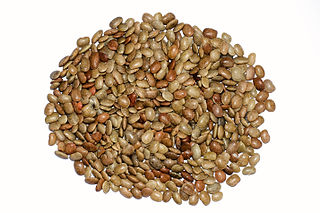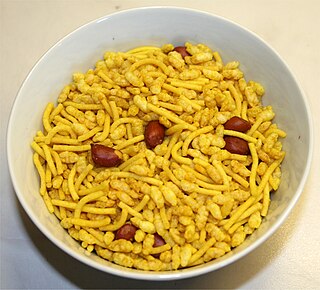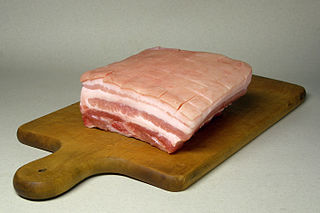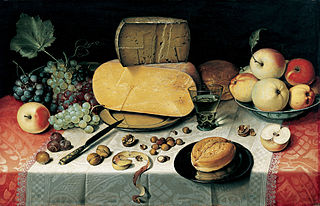Related Research Articles
Hot salt frying and hot sand frying are cooking techniques used by street-side food vendors in Bangladesh, Pakistan, China and India. Hot salt frying is an old cooking technique, and is used in villages throughout Asia and other parts of the world. Many foods are fried with hot salt or sand, even in common households.

Indian cuisine consists of a variety of regional and traditional cuisines native to the Indian subcontinent. Given the diversity in soil, climate, culture, ethnic groups, and occupations, these cuisines vary substantially and use locally available spices, herbs, vegetables, and fruits.

Macrotyloma uniflorum is a legume native to tropical southern Asia, commonly grown for horse feed and occasionally for human consumption and in Ayurvedic cuisine. Horse gram is grown in Andhra Pradesh, Bihar, Chhattisgarh, Himachal Pradesh, Jharkhand, Karnataka, Madhya Pradesh, Maharashtra, Orissa, Tamil Nadu, Uttarakhand, Jammu and Kashmir, and West Bengal in India, as well as in Malaysia, Sri Lanka, the West Indies, and elsewhere. It is consumed as a whole seed, as sprouts, or as whole meal in India, popular in many parts of India. Medical uses of these legumes have been discussed.

Bhelpuri is a savoury snack originating from India, and is also a type of chaat. It is made of puffed rice, vegetables and a tangy tamarind sauce, and has a crunchy texture.

Upma, uppumavu or uppittu is a dish originating from the Indian subcontinent, most common in Kerala, Andhra Pradesh, Tamil Nadu,Karnataka, Maharashtrian, Gujarat, Odia and Sri Lankan Tamil breakfast, cooked as a thick porridge from dry-roasted semolina or coarse rice flour. Various seasonings and/ vegetables are often added during the cooking, depending on individual preferences. Today it is popular in most parts of India and is prepared in various ways.

Chicharrón is a dish generally consisting of fried pork belly or fried pork rinds. Chicharrón may also be made from chicken, mutton or beef.

Sev mamra (mumra) is an Indian snack. It is a mixture of spicy dry ingredients such as puffed rice (mamra), savoury noodles (sev) and peanuts.

Puffed rice and popped rice, are types of puffed grain made from rice commonly eaten in the traditional cuisines of Southeast Asia, East Asia, and South Asia. It has also been produced commercially in the West since 1904 and is popular in breakfast cereals and other snack foods.
Mithai (sweets) are the confectionery and desserts of the Indian subcontinent. Thousands of dedicated shops in India, Pakistan, Bangladesh, Nepal and Sri Lanka sell nothing but sweets.

A rice cake may be any kind of food item made from rice that has been shaped, condensed, or otherwise combined into a single object. A wide variety of rice cakes exist in many different cultures in which rice is eaten and are particularly prevalent in Asia. Common variations include cakes made with rice flour, those made from ground rice, and those made from whole grains of rice compressed together or combined with some other binding substance.

Indian breads are a wide variety of flatbreads and crêpes which are an integral part of Indian cuisine. Their variation reflects the diversity of Indian culture and food habits.

South Indian cuisine includes the cuisines of the five southern states of India—Andhra Pradesh, Karnataka, Kerala, Tamil Nadu and Telangana—and the union territories of Lakshadweep, Pondicherry, and the Andaman and Nicobar Islands.There are typically vegetarian and non-vegetarian dishes for all five states. Additionally, all regions have typical main dishes, snacks, light meals, desserts, and drinks that are well known in their respective region.

Poha, also known as pauwa, chira, or aval, among many other names, is flattened rice originating from the Indian subcontinent. Rice is parboiled before flattening so that it can be consumed with very little to no cooking. These flakes of rice swell when added to liquid, whether hot or cold, as they absorb water, milk or any other liquids. The thickness of the flakes varies between almost translucently thin to nearly four times thinner than a normal rice grain.

Dried shrimp are shrimp that have been sun-dried and shrunk to a thumbnail size. They are used in many East Asian, Southeast Asian and South Asian cuisines, imparting a unique umami taste. A handful of shrimp is generally used for dishes. The flavors of this ingredient are released when allowed to simmer.

Sachima is a sweet snack in Chinese cuisine made of fluffy strands of fried batter bound together with a stiff sugar syrup, somewhat similar to American Rice Krispies Treats. It originated in Manchuria, which is now Northeast China. It is a popular snack throughout many regions in China. Its decoration and flavor vary in different regional Chinese cuisines, but the appearance of all versions is essentially the same.

Ghugni is a snack, native to the Indian subcontinent, especially popular in Eastern India, Northeast India and in neighbouring country Bangladesh. Black gram, dried yellow peas, or dried white peas are cooked with gravy in the traditional style. It is then served with puffed rice (kurmura) and at times with hot onion pakoda or bhajiya. It is also served with poori. Some versions include meat, such as goat or even lamb or chicken. The meat is usually minced or in bite-sized pieces, mostly for flavoring. "Mangsher ghugni" or meat keema ghugni has been described as a "Kolkata trademark". It is a common and affordable food throughout Bangladesh, especially during Ramadan.
Sattu is a type of flour, mainly used in Nepal, India, Bangladesh and Pakistan. It consists of a mixture of ground pulses and cereals. The dry powder is prepared in various ways as a principal or secondary ingredient of dishes. Various varieties of sattu are prepared in both countries: during Bathukamma in Telangana, and as a refreshing drink among farmers during summers in Pakistan.

Bamboo shoots or bamboo sprouts are the edible shoots of many bamboo species including Bambusa vulgaris and Phyllostachys edulis. They are used as vegetables in numerous Asian dishes and broths. They are sold in various processed shapes, and are available in fresh, dried, and canned versions.

Pork rind is the culinary term for the skin of a pig. It can be used in many different ways.

A snack is a small portion of food generally eaten between meals. Snacks come in a variety of forms including packaged snack foods and other processed foods, as well as items made from fresh ingredients at home.